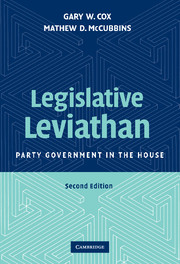Book contents
- Frontmatter
- Contents
- List of Figures
- List of Tables
- Acknowledgments
- Legislative Leviathan
- Introduction
- PART ONE THE AUTONOMY AND DISTINCTIVENESS OF COMMITTEES
- PART TWO A THEORY OF ORGANIZATION
- PART THREE PARTIES AS FLOOR-VOTING COALITIONS
- PART FOUR PARTIES AS PROCEDURAL COALITIONS
- PART FIVE PARTIES AS PROCEDURAL COALITIONS
- Conclusion
- Appendix 1 Uncompensated Seniority Violations, Eightieth through Hundredth Congresses
- Appendix 2 A Model of the Speaker's Scheduling Preferences
- Appendix 3 Unchallengeable and Challengeable Vetoes
- Appendix 4 The Scheduling Power
- Bibliography
- Author Index
- Subject Index
PART ONE - THE AUTONOMY AND DISTINCTIVENESS OF COMMITTEES
Published online by Cambridge University Press: 05 June 2012
- Frontmatter
- Contents
- List of Figures
- List of Tables
- Acknowledgments
- Legislative Leviathan
- Introduction
- PART ONE THE AUTONOMY AND DISTINCTIVENESS OF COMMITTEES
- PART TWO A THEORY OF ORGANIZATION
- PART THREE PARTIES AS FLOOR-VOTING COALITIONS
- PART FOUR PARTIES AS PROCEDURAL COALITIONS
- PART FIVE PARTIES AS PROCEDURAL COALITIONS
- Conclusion
- Appendix 1 Uncompensated Seniority Violations, Eightieth through Hundredth Congresses
- Appendix 2 A Model of the Speaker's Scheduling Preferences
- Appendix 3 Unchallengeable and Challengeable Vetoes
- Appendix 4 The Scheduling Power
- Bibliography
- Author Index
- Subject Index
Summary
We reevaluate the role of parties and committees in the postwar House of Representatives, arguing that parties are a kind of legislative cartel that seizes the structural power of the House and that committees are definitely not autonomous. Such a reevaluation will not even get off the ground if the reader is committed to the dominant “committee government” model of the Rayburn Congress. Accordingly, in this part of the book, we critique some key aspects of this model.
Virtually all researchers on the postwar House of Representatives speak of the standing committees as being “autonomous.” What autonomy means varies from context to context. In reference to committee jurisdictions, autonomy refers to their statutory status and fixity. In reference to committee personnel, autonomy generally refers to some fairly specific “rights” conferred by the seniority system on committee members and to the lack of any real party control over who gets on most committees. In reference to committee involvement in subgovernments, autonomy refers to the ability of small groups of committee members, executive bureaucrats, and business lobbyists to make policy independently of the larger political arena.
In this part we deal with the latter two notions of autonomy, regarding personnel and decision making, leaving aside the issue of jurisdictional fixity. The notion of subgovernments also touches on the degree to which committees are distinctive or unrepresentative.
- Type
- Chapter
- Information
- Legislative LeviathanParty Government in the House, pp. 15 - 16Publisher: Cambridge University PressPrint publication year: 2007



